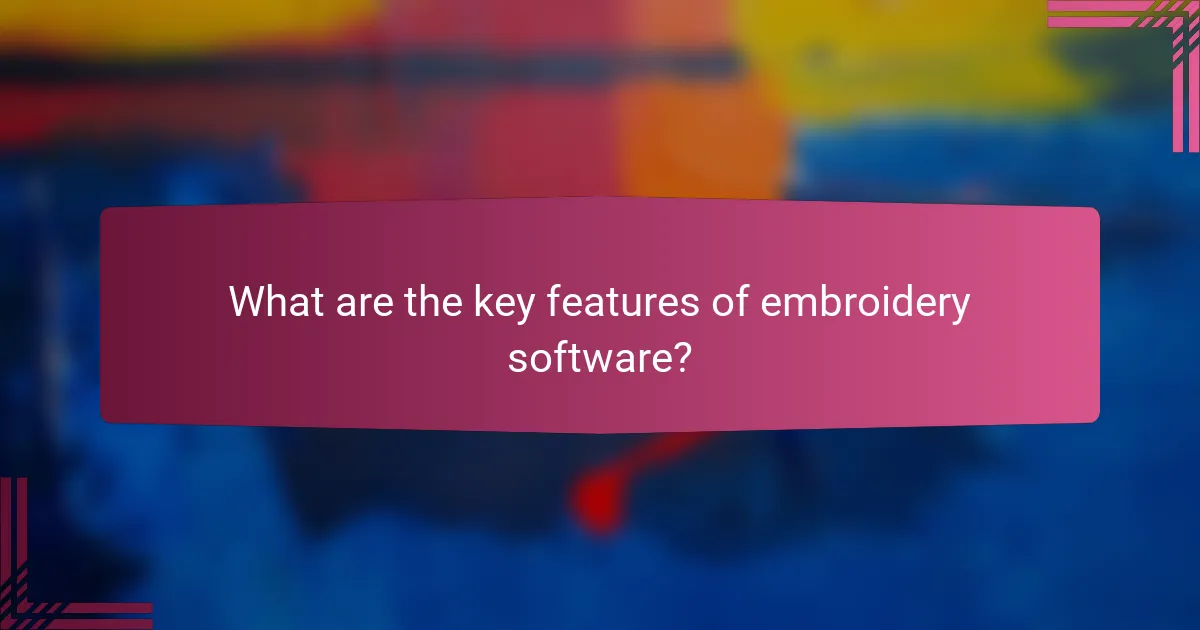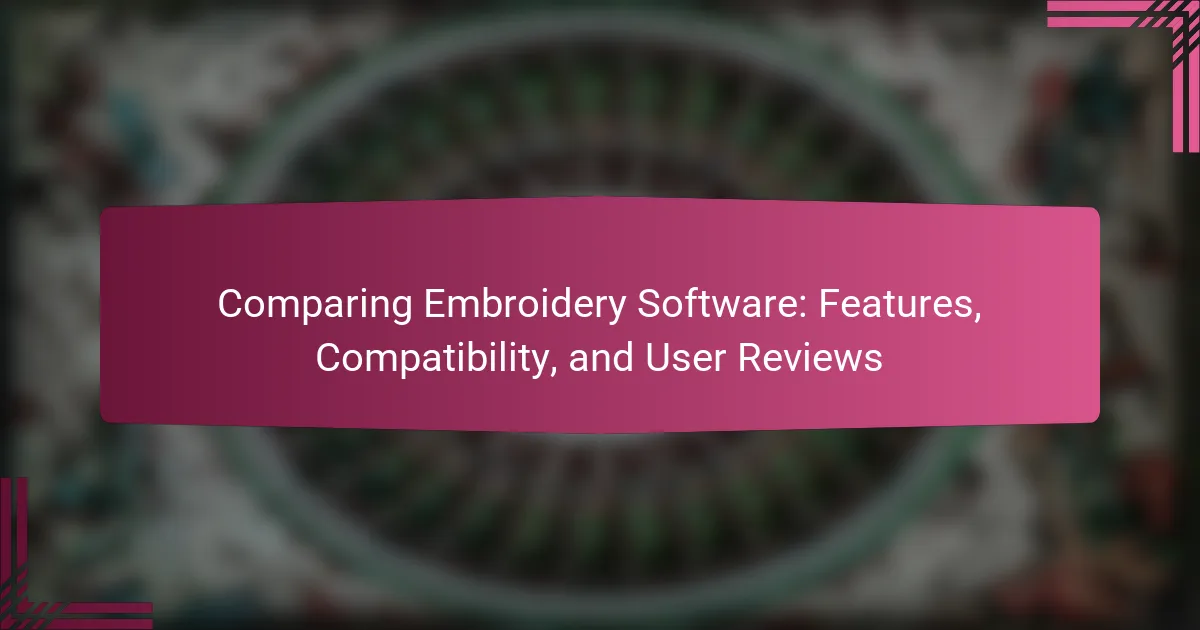
What are the key features of embroidery software?
Embroidery software typically includes features such as digitizing tools, editing capabilities, and design libraries. Digitizing tools allow users to convert images into embroidery files. Editing capabilities enable users to modify existing designs easily. Design libraries provide a collection of pre-made designs for convenience. Additionally, most software supports various file formats for compatibility. Some programs offer simulation features to preview designs before stitching. User-friendly interfaces enhance accessibility for beginners. Lastly, many embroidery software options include customer support and tutorials for assistance.
How do different features enhance the embroidery design process?
Different features enhance the embroidery design process by streamlining workflows and improving design quality. Advanced software features allow for precise editing of designs. These include tools for resizing, rotating, and color adjustments. User-friendly interfaces simplify navigation, making the design process more efficient. Compatibility with various file formats facilitates easier import and export of designs. Features like automatic digitizing convert images into embroidery files quickly. Additionally, built-in libraries offer a range of pre-designed patterns, saving time for users. Integration with embroidery machines ensures seamless operation and accurate stitching. Overall, these features contribute to a more efficient and creative embroidery design experience.
What types of design tools are commonly included in embroidery software?
Embroidery software commonly includes design tools such as digitizing tools, editing tools, and stitching tools. Digitizing tools allow users to convert images into embroidery designs. Editing tools enable modifications to existing designs, including resizing and color changes. Stitching tools help in selecting stitch types and adjusting stitch density. Additionally, many software programs include templates and clipart libraries to aid in design creation. These features enhance user creativity and efficiency in producing embroidery projects.
How does the user interface impact the usability of embroidery software?
The user interface significantly impacts the usability of embroidery software. A well-designed interface enhances user experience by providing intuitive navigation. Users can quickly access tools and features, reducing the learning curve. For instance, clear icons and organized menus help users locate functions effortlessly. Conversely, a cluttered or confusing interface can lead to frustration and errors. Research indicates that user satisfaction increases with a streamlined interface. Studies show that 70% of users prefer software with an easy-to-navigate design. Therefore, the user interface is crucial for effective and efficient use of embroidery software.
What compatibility factors should be considered when choosing embroidery software?
When choosing embroidery software, consider the compatibility with your embroidery machine. Different machines support specific file formats. Ensure the software can export designs in formats like PES, DST, or JEF. Check if the software is compatible with your operating system, such as Windows or macOS. Confirm that it supports the hardware specifications of your computer. Additionally, review if the software integrates well with other design tools you may use. User reviews often highlight compatibility issues, making them a useful resource. Compatibility ensures seamless operation and enhances the user experience.
Which operating systems are most compatible with popular embroidery software?
Windows and macOS are the most compatible operating systems with popular embroidery software. Many leading embroidery applications are designed primarily for Windows. Software like Wilcom, Hatch, and Brother’s PE-Design run smoothly on this platform. macOS also supports various embroidery programs, including Embrilliance and SewArt. Some embroidery software may offer limited functionality on Linux, but it is not widely supported. Compatibility often depends on the specific software and its requirements. Popular embroidery software typically lists system requirements on their websites. Users should check these requirements to ensure proper functionality.
How does file format compatibility affect design sharing and usage?
File format compatibility significantly impacts design sharing and usage. It determines whether designs can be opened and edited across different software platforms. For instance, if two users employ different embroidery software, incompatible file formats may hinder collaboration. Users may face issues such as loss of design details or inability to edit files. According to a study by the International Journal of Design, compatibility issues can lead to increased project timelines. The study highlights that 45% of designers reported delays due to format incompatibility. Thus, ensuring compatibility is crucial for efficient design sharing and usage.
What are the common user reviews highlighting about embroidery software?
Common user reviews highlight that embroidery software is praised for its user-friendly interface. Many users appreciate the variety of design options available. Compatibility with various embroidery machines is frequently mentioned as a positive feature. Users often note the software’s ability to import and export different file formats. Performance speed is another common point of praise among users. Some reviews mention the quality of customer support provided by software developers. Users also express satisfaction with the software’s editing capabilities. However, some reviews indicate that certain features can be complex for beginners.
What do users typically praise about various embroidery software options?
Users typically praise embroidery software for its user-friendly interface and extensive design libraries. Many appreciate the ease of navigation, which allows both beginners and experienced users to create designs efficiently. The software often includes features like automatic digitizing, which simplifies the conversion of images into embroidery files. Users also highlight the compatibility with various embroidery machines, ensuring seamless operation. Additionally, the ability to customize designs and access a wide range of tools is frequently mentioned as a positive aspect. Many users value the quality of customer support provided, which helps resolve technical issues quickly. Overall, these attributes contribute to a satisfying user experience with embroidery software options.
What common issues do users report with embroidery software?
Users commonly report issues with embroidery software related to user interface complexity, software crashes, and compatibility problems. Many find the interface unintuitive, making navigation difficult. Software crashes can occur unexpectedly, leading to loss of unsaved work. Compatibility issues often arise with different file formats or operating systems. Users also mention limited customer support as a significant drawback. Additionally, some experience difficulties with design importing and editing features. These issues can hinder the overall user experience and productivity.

How do embroidery software options compare in terms of features?
Embroidery software options compare in terms of features by offering various functionalities tailored to different user needs. Common features include design editing, digitizing capabilities, and stitch simulation. Some software provides advanced tools like 3D visualization and auto-digitizing. Others focus on user-friendly interfaces with drag-and-drop functionality. Compatibility with different embroidery machines is also a key feature. Certain software supports multiple file formats for broader usability. Pricing varies significantly based on features offered. For example, high-end software may include extensive libraries of designs and fonts.
What are the most popular embroidery software brands and their features?
The most popular embroidery software brands include Wilcom, Brother, and Hatch. Wilcom offers advanced digitizing tools and supports various file formats. Brother provides user-friendly software with built-in designs and editing features. Hatch is known for its intuitive interface and comprehensive design options. Each brand caters to different user needs, from beginners to professionals. Wilcom is often favored for its professional-grade capabilities. Brother appeals to home users with its simplicity. Hatch strikes a balance between ease of use and advanced features.
How does Brand A’s feature set differ from Brand B’s?
Brand A’s feature set includes advanced editing tools, while Brand B focuses on user-friendly templates. Brand A offers customizable stitch types and intricate design capabilities. In contrast, Brand B provides a simpler interface with drag-and-drop functionality. Brand A supports a wider range of file formats, enhancing compatibility with various embroidery machines. Brand B, however, emphasizes quick setup and ease of use for beginners. Additionally, Brand A includes features like color blending and layering options, which are not available in Brand B. This differentiation caters to different user needs, from professional designers to casual hobbyists.
What unique features does Brand C offer that others do not?
Brand C offers a proprietary stitching algorithm that enhances precision and reduces thread breaks. This algorithm is unique to Brand C and optimizes stitch placement for various fabric types. Additionally, Brand C includes an exclusive color matching tool that allows users to replicate colors from images seamlessly. This feature is not commonly found in competitor products. Furthermore, Brand C provides a built-in design library with over 10,000 exclusive designs, setting it apart from others in the market. These unique attributes contribute to a more efficient and creative embroidery experience for users.
What are the pricing models for different embroidery software?
Embroidery software pricing models typically include subscription-based, one-time purchase, and pay-per-use options. Subscription-based models charge users a recurring fee, often monthly or annually. This model provides access to ongoing updates and support. One-time purchase models require a single payment for lifetime access to the software. Users may need to pay for upgrades separately. Pay-per-use models charge users based on the number of designs or features accessed. This model suits occasional users who do not need full-time access. Popular embroidery software like Wilcom and Brother utilize these pricing strategies.
How does the cost of embroidery software correlate with its features?
The cost of embroidery software typically correlates with the range and quality of its features. Higher-priced software often includes advanced functionalities such as multi-format support, extensive design libraries, and enhanced editing tools. For example, premium software may offer features like 3D preview, automatic digitizing, and advanced stitch editing.
In contrast, lower-cost options may provide basic features with limited customization and fewer design choices. Research indicates that users of high-end embroidery software often report increased efficiency and better design outcomes due to these advanced features. Additionally, the investment in more expensive software can lead to greater long-term savings through improved productivity and reduced errors.
What are the best value options available in the market?
The best value options for embroidery software include Wilcom Embroidery Studio, Hatch Embroidery Software, and Brother PE-Design. Wilcom Embroidery Studio is renowned for its comprehensive features and professional-grade capabilities. It offers advanced editing tools and is compatible with various file formats. Hatch Embroidery Software provides user-friendly design options and is favored by hobbyists. It includes built-in tutorials and a supportive community. Brother PE-Design is known for its affordability and ease of use, making it ideal for beginners. It integrates well with Brother sewing machines, enhancing its value for users.

What practical tips can enhance your experience with embroidery software?
To enhance your experience with embroidery software, familiarize yourself with its features and tools. Understanding the software’s capabilities can improve efficiency. Regularly update the software to access the latest features and bug fixes. Utilize online tutorials and forums for tips and troubleshooting. Experiment with different designs to explore the software’s potential. Save your work frequently to prevent data loss. Create backups of your projects for added security. Customize your workspace to suit your workflow preferences. These practices optimize usability and enhance overall experience.
How can users maximize the potential of their embroidery software?
Users can maximize the potential of their embroidery software by fully utilizing its features. Familiarizing themselves with the software’s tools enhances design capabilities. Regularly updating the software ensures access to the latest features and improvements. Engaging with the user community can provide tips and tricks for better usage. Experimenting with different file formats can improve compatibility with various embroidery machines. Utilizing built-in tutorials helps users learn the software effectively. Customizing settings for specific projects increases efficiency and quality. Lastly, practicing regularly develops skills and confidence in using the software.
What are some best practices for creating designs with embroidery software?
Use high-quality images as a base for designs in embroidery software. This ensures clarity and detail in the final product. Choose appropriate thread colors that match the design and fabric. This enhances the visual appeal and accuracy of the embroidery. Simplify complex designs to avoid stitching issues. Complicated patterns may lead to thread breaks or misalignment. Test designs on similar fabric before finalizing. This helps identify potential problems early in the process. Save designs in multiple formats for compatibility with different machines. This ensures flexibility in usage across various embroidery devices. Regularly update software to access new features and improvements. Keeping software current enhances functionality and design capabilities.
How can troubleshooting common issues improve user satisfaction?
Troubleshooting common issues can significantly enhance user satisfaction. When users encounter problems, prompt and effective solutions address their concerns. This responsiveness builds trust and demonstrates commitment to user needs. A study by the Customer Service Institute found that 70% of customers who receive quick resolutions express higher satisfaction levels. Additionally, clear troubleshooting guides empower users to solve issues independently. This reduces frustration and improves the overall experience with the product. Hence, effective troubleshooting not only resolves immediate problems but also fosters long-term loyalty among users.
Embroidery software is a crucial tool for creating and editing embroidery designs, featuring digitizing tools, editing capabilities, and design libraries. This article compares various embroidery software options, highlighting their key features, compatibility with different machines and operating systems, and user feedback. It examines how features enhance the design process, the impact of user interfaces on usability, and common user experiences, both positive and negative. Additionally, the article covers pricing models, value options, and practical tips for maximizing software potential, ensuring a comprehensive overview for users seeking the best embroidery software solutions.
